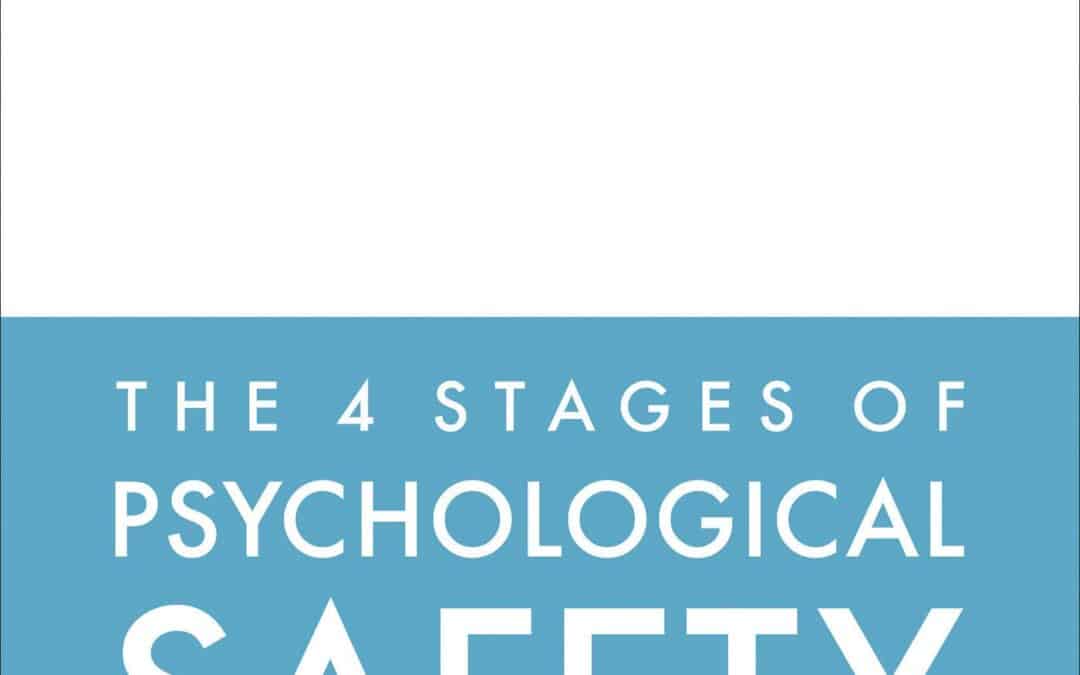What is important about this book
Human beings have four basic needs: fulfillment, belonging, security, and physical needs. Once physical needs (food and shelter) are met, Psychological Safety becomes a priority, as it straddles all others in the hierarchy of human needs.
Psychological Safety is the condition in which:
- you feel included,
- safe to learn (even from failures),
- safe to contribute,
- safe to innovate and safe to challenge the status quo
all without the fear of being embarrassed, marginalized, or punished in some way.
The author proposes Psychological Safety as a progression based on the natural sequence of human needs and despite unique life stories, we share common experiences: first, we want to be included; second, to learn; third, to contribute; and finally, to innovate and challenge the status quo when change is needed. This pattern is consistent across all organizations and social units.
This book’s author is Timothy R. Clark, founder and CEO of LeaderFactor, a global leadership consulting and training organization. He earned a Ph.D. in social science from Oxford University. He is also the author of Leading with Character and Competence.
Quotes
- “In the twenty-first century, high psychological safety will increasingly become a term of employment, and organizations that don’t supply will bleed out their top talent”
- “The presence of fear in an organization is the first sign of weak leadership”
- “Organizations don’t outperform their leaders, they reflect them”
- “Where there is no tolerance for candor, there is no constructive dissent. Where there is no constructive dissent, there is no innovation”
- “Psychological Safety is directly related to team performance and business impact”
- “To scale innovation throughout the organization, leaders must establish a norm of challenging the status quo”
- “The need to be accepted precedes the need to be heard”
Structure and contents of the book
This book a practical, hands-on guide that shows how leaders can build psychological safety in their organizations, creating an environment where employees feel included, fully engaged, and encouraged to contribute their best efforts and ideas.
The 4 stages of Psychological Safety has a very simple structure: preface, four chapters (called stages) and conclusions. The content mainly revolves around a framework called “the four stages of psychological safety” that, according to Tim Clark, can be used as a diagnostic tool to assess the stage of psychological safety in any organization or social unit.
Stage 1: Inclusion Safety. This first stage involves being accepted into the team and the sharing of an identity. Inclusion safety goes beyond tolerance – it doesn’t mask or ignore differences. It is built and sustained through ongoing acceptance and repeated signals of belonging.
Stage 2: Learner Safety. This stage means you feel safe to ask questions, experiment, and make mistakes. Without it, you may stay passive, fearing you’ll cross an unspoken line. A learning-safe environment unlocks potential by building confidence, resilience, and independence. Unlike the first stage, learner safety requires active participation within clear boundaries.
Stage 3: Contributor Safety. At this stage, you’re invited – and expected – to contribute actively in your role, based on one’s own ideas and trust in one’s competence. It arises when performance is solid, and it’s sustained by encouragement and the right level of autonomy from both leader and team.
Stage 4: Challenger Safety. This stage allows you to challenge the status quo without fear of retribution or harm to your reputation. It gives you the confidence to speak up when change is needed and to resist conformity by engaging in the creative process. Challenger safety is a license to innovate. Leaders must manage the tension this creates, draw out collective genius, and sustain innovation through trial and error. Yet many organizations resist it, fearing threats to power structures, incentives, etc. Still, challenger safety is essential – it’s the cultural foundation for ongoing innovation, improving and growth.
Instructions for reading this book
This book is written in a fluent style, enriched with charts, illustrations, quotes, and real-world examples – from the author’s experience and third-party case studies. It’s primarily addressed to business leaders, but its message speaks to anyone interested in improving human interaction.
The 4 stages of Psychological Safety explores what breaks our relationships and how we can rebuild them – by decoding silence, freeing our voices, and learning to connect one another more effectively. The author shares what he has learned about how Psychological Safety shapes our behavior, performance, and happiness.
Right from the start, the invitation is clear: “Please don’t read this book for information, read it for action. Read it for change. Crack yourself open and look inside. This is a time to summon the courage to conduct a searching, fearless personal inventory”.
Clark reminds us that perfection doesn’t exist – not in people, parents, teachers, or coaches. We’re all flawed and unfinished, yet full of potential. Diversity means little unless its value is unlocked, and leaders must act as social architects who create the conditions for people to feel included, to learn, to contribute, and to innovate. It is the culminating stage of both leadership development and organizational culture to create and sustain this kind of environment.
Psychological Safety doesn’t happen by accident. It starts with setting the tone, modeling the behavior, and choosing to lead. As the author says: “you either show the way or get in the way”. If you commit to this journey, you won’t just change your organization – you’ll transform families, schools, and communities, helping others live fuller, more creative, connected lives.
